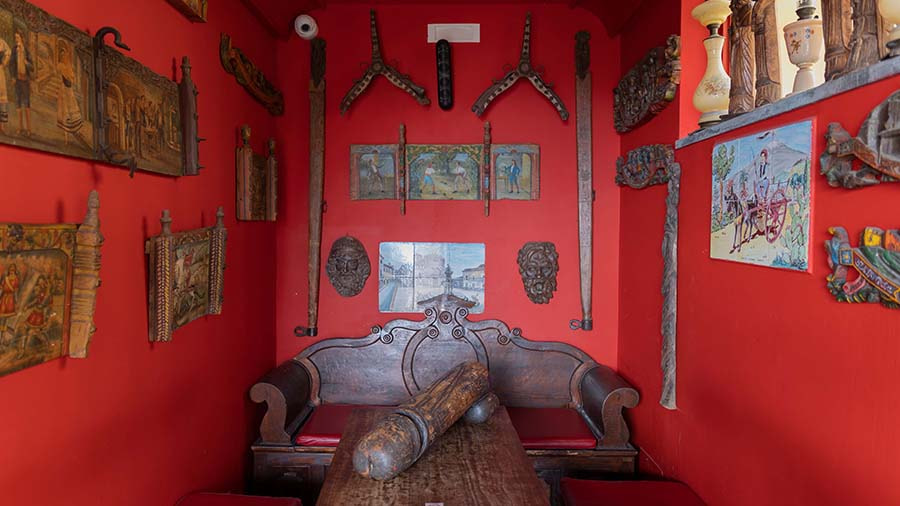Are you planning your visit to Taormina and have discovered that one of the Most Beautiful Villages in Italy is just a short distance away? Maybe your question is: what are the things to do in Castelmola? Great, this article is a complete guide to all the places of interest found in this beautiful village.
How to get to Castelmola
The best way to get to Castelmola is by bus. This will save you the stress of driving on a narrow two-lane road with all the curves and hills. You will also avoid the problem of parking. If you decide to reach Castelmola by car, you can leave your car in a paid parking lot just outside the village or, if you are lucky, just before you enter the village. It is also possible to reach Castelmola on foot directly from Taormina. In fact, there is an old mule track, now paved, called the Saracen Trail. If you like trekking, this can be an interesting option. First you reach the Porta dei Saraceni, the ancient entrance to the town of Castelmola, and then you reach the outskirts of the town, where the church of San Biagio is located.
Things to do in Castelmola: the tour of the village
If you decide to go to Castelmola by car or by bus, your tour to discover this beautiful village will start from Piazza Sant’Antonio. About ten meters before the entrance to the village, there is the icon of the Madonna delle Scale. An oil painting of unknown date is kept here. A half-day tour of the village is sufficient, but it is important to coordinate with the bus schedules because they are not very frequent.
Piazza Sant’Antonio, the ancient Roman Arch and the Auditorium

At the beginning of our list of things to do in Castelmola, we have a visit to Piazza Sant’Antonio. It is a real terrace from which it is possible to admire a breathtaking panorama that embraces the Strait of Messina and Taormina. The square, built in 1954, has a beautiful mosaic pavement with alternating lava stones and white stones. In Piazza Sant’Antonio there is an Ancient Roman arch dating back to 900 AD. It originally stood at the top of a flight of steps carved into the rock, just after the “Porta di Mola”, the main entrance to the village. In 1954, during the construction of Piazza Sant’Antonio, the arch was isolated and placed on a flight of limestone steps. Next to the arch is the Castelmola Auditorium. It was originally a church dedicated to St. Anthony, which was transformed into a parish oratory in 1953. Today it is used for meetings, events and civil weddings.
The Antico Caffè San Giorgio

Just in front of the ancient Roman arch is one of the historical places to visit in Castelmola. It is the Antico Caffè San Giorgio, founded in 1700 by some monks as a tavern. The great success of this establishment began when the ownership passed to Don Vincenzo Blandano. In fact, it was thanks to his wisdom that the Antico Caffè San Giorgio became famous and attracted the many foreign tourists who began to arrive in Taormina in the 1800s. This café is known all over the world as the place where the typical product of Castelmola was invented: the almond wine. There is another reason to visit the Antico Caffè San Giorgio, and that is the “book of a hundred thousand autographs”. In fact, Don Vincenzo Blandano used to ask all the famous people who visited his cafe for a signature. The tradition was continued by his descendants and among the many signatures are those of Guglielmo Marconi, Winston Churchill and Pope Wojtyla.
The Mola Castle

Going down the stairs to the left of the Castelmola Auditorium, one reaches the Mola Castle. The view of the Strait of Messina can be appreciated even more. It is also possible to understand the defensive importance of the castle, not only for Castelmola. In fact, from this position there is also a perfect view of the castle of Taormina, which is located on Monte Tauro. There is very little information about the history of the castle. The only hint comes from a plaque with engravings in Byzantine Greek, found in the main façade of the Cathedral of Castelmola. According to historians, it is most likely that the first construction of the building dates back to the Roman period. Inside is a small medieval museum and is home to the International School of Falconry.
The church of San Giorgio

Walking through the streets of the village of Castelmola, you will come across the church of San Giorgio. It is a small one-nave church built around 1450. The most interesting element of the building is undoubtedly the bell tower. It consists of a short tower integrated in the body of the building and in its four corners there are four pyramidal pinnacles (clochetons). Each of them holds a small stone ball. Inside the church is the statue that is carried in procession through the streets of the village every year on April 23rd, the feast of St. George of Castelmola.
The Cathedral of San Nicola

The next stop in the discovery of things to see in Castelmola leads to Piazza Chiesa Madre. Here you will find the Cathedral of San Nicola, the Municipal Library and a beautiful belvedere from where you can admire the view. The famous Bar Turrisi also overlooks this square. The Cathedral of St. Nicholas, rebuilt in 1934-35, is a splendid example of the fusion of different architectural styles. In fact, elements from Roman to Gothic and from Arab to Norman can be recognized. The interior has a single nave and retains only the original 16th century elements in the side portal and the choir arch. The Cathedral of Castelmola also preserves some interesting works of art, such as the two 18th century statues of Mary Magdalene and Our Lady of the Rosary.
The Bar Turrisi

One of the most important things to do in Castelmola is to visit the Bar Turrisi. In case you do not know, it is a very special place that the magazine Focus included among the “seven most special places in the world”. The reason is simple: every element of the interior is in the shape of a phallus. Menus, chair arms, door handles, and floor tiles all resemble or explicitly evoke the male organ. This is not to say that it is not a very pleasant place to have lunch or spend time with friends. The atmosphere inside certainly makes for a strange but fascinating stay. The characteristic almond wine is also served in the Bar Turrisi. If you prefer, you can taste it in a glass, obviously in the shape of a phallus, which you can take with you.
The church of San Biagio

Moving towards the outskirts of Castelmola is the church of San Biagio. To reach it, it is necessary to walk a short stretch paved in stone and then some stairs. The effort, not excessive, is certainly rewarded. The church of San Biagio is definitely one of the must-sees in Castelmola. In fact, it is located in one of the most beautiful spots of the village, from where you can admire the landscape. The church itself offers a really impressive scenic view, nestled among a huge amount of prickly pears. The church of San Biagio is one of the oldest in Castelmola and inside you can admire some remains of an 18th century fresco cycle depicting a “Madonna with Child, St. Blaise and Angels”. Going down the stairs you will find the Porta dei Saraceni and then you will reach Taormina.
Things to do in Castelmola: sights to visit outside the village
If you have more than half a day to visit Castelmola, you can extend your itinerary. In fact, there are other places of interest outside the village. If you like trekking, you can try the route that leads to the top of Mount Venus. It is also possible to go paragliding from here.
The Church of the Annunziata
Walking a little outside the village of Castelmola, you will come across the Church of the Santissima Annunziata. The building dates back to 1100, when Roger the Norman had it built as a sign of gratitude to the Virgin Mary for her help in the victorious war against the Saracens. The church, which is very small, has a single nave inside. Over the years it has undergone several transformations and modifications, such as the addition of a small room with direct access from the cemetery. The church of the Annunziata is rarely open to the public. However, the most interesting artistic element can be seen from the outside. It is the entrance portal, probably from the late Romanesque period.
The Roman Wells of Myle
Walking along the Saracen Way, in addition to the ancient Saracen gate, you will come across other important vestiges of the ancient city of Myle. In fact, it is possible to see the remains of the so-called necropolis of Cocolonazzo. This is an archaeological site discovered in 1919 and dating back to the 10th-7th century BC. Inside some of the caves were found several artifacts dating back to the Iron Age, which are now exhibited in the Paolo Orsi Archaeological Museum in Syracuse. Three ancient cisterns for water collection are also visible in this area. They were built in 367 B.C. by the tyrant of Taormina, Andromaco, to improve the living conditions of the inhabitants of the area.














